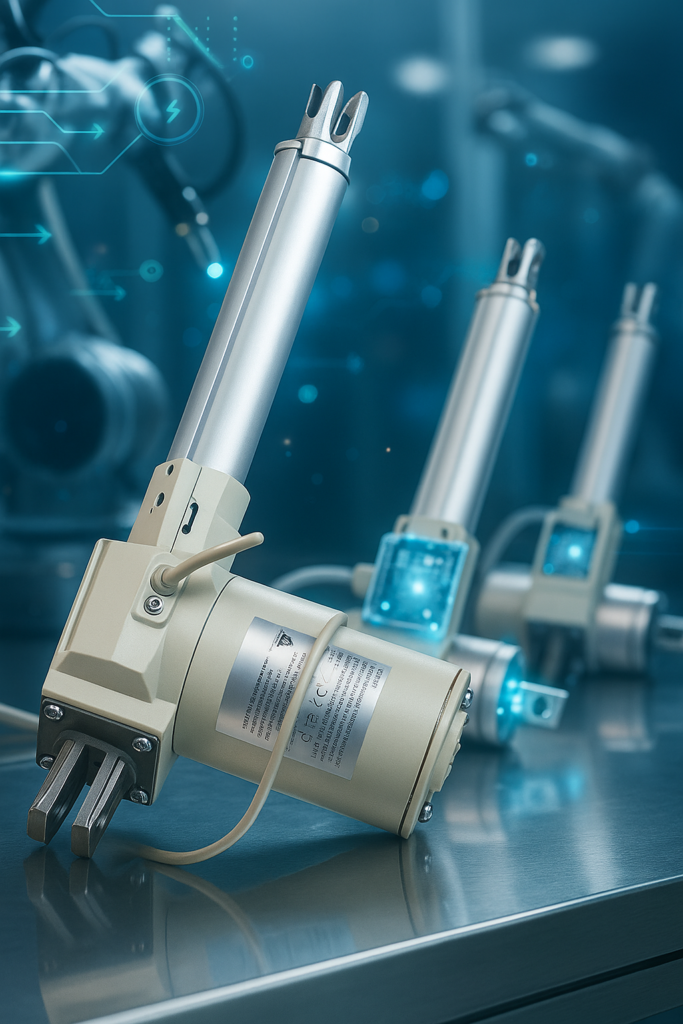The world of motion control is evolving fast — and at the heart of this transformation are linear actuators. Once considered simple devices for pushing, pulling, or lifting, today’s actuators have become intelligent motion systems that blend precision, silence, and energy efficiency. From industrial automation to medical equipment and home innovation, smarter and quieter actuators are redefining how machines move.

The Rise of Smarter Motion
Modern applications demand more than just mechanical power. They demand intelligence. Smart linear actuators now come with built-in sensors, controllers, and feedback systems that can monitor position, speed, and load in real time.
Key Smart Features:
- Position Feedback: Integrated encoders or Hall sensors ensure pinpoint positioning and repeatable accuracy.
- Onboard Control: Actuators now perform motion tasks independently, reducing the load on PLCs and control panels.
- Predictive Maintenance: By monitoring vibration, current, and temperature, actuators can alert systems before a fault occurs.
- IoT Connectivity: Many actuators support protocols like Modbus, CANopen, or even wireless monitoring, linking them directly to Industry 4.0 platforms.
Result: Smarter actuators simplify design, reduce maintenance, and improve overall system reliability.
The Power of Quiet Precision
In environments like hospitals, laboratories, and offices, noise control is critical. The new generation of actuators operates with whisper-quiet efficiency, combining smooth mechanics with advanced electronics.
How They Stay Silent:
- Brushless DC Motors (BLDC): Smooth, frictionless rotation eliminates motor hum and mechanical chatter.
- Precision Lead Screws & Ball Screws: Designed with tight tolerances and anti-backlash systems to minimize vibration.
- Advanced Motion Algorithms: Soft-start and soft-stop functions reduce jerks and create fluid movement.
- Noise-Damping Materials: Composite housings and polymer bushings absorb mechanical noise.
Result: A calm, efficient motion — perfect for hospital beds, adjustable work tables, and collaborative robots.
The Push Toward Energy Efficiency
Efficiency isn’t just a trend — it’s a necessity. Whether powered by mains or battery, energy-efficient actuators reduce consumption, heat generation, and environmental impact.
Energy-Saving Innovations:
- High-Efficiency Motors: Modern motor designs convert more electrical energy into linear force.
- Low-Friction Mechanisms: Enhanced bearings and coatings reduce resistance, saving power.
- Regenerative Control: Some designs recover energy when lowering loads or braking.
- Optimized Power Electronics: Smarter PWM and MOSFET circuits cut switching losses and heat.
Result: Lower energy costs, longer battery life, and a smaller carbon footprint.
Real-World Applications
Smarter, quieter, and more efficient actuators are reshaping multiple industries:
- Industrial Automation: For assembly lines, conveyors, and pick-and-place systems requiring precision and reliability.
- Medical Equipment: In patient beds, surgical tables, and imaging systems — where quiet operation is vital.
- Renewable Energy: For solar panel trackers and wind systems needing efficient, long-life motion.
- Automotive: For seat adjusters, active spoilers, and adaptive components.
- Smart Furniture & Home Automation: For adjustable desks, TV lifts, and ergonomic workstations.
The Future of Linear Motion
Tomorrow’s actuators won’t just move objects — they’ll analyze, adapt, and optimize every motion. We’re heading toward:
- AI-driven control algorithms that learn motion patterns.
- Wireless diagnostics and cloud-based maintenance alerts.
- Compact yet powerful designs with minimal environmental impact.
The evolution of linear actuators mirrors the evolution of automation itself — intelligent, efficient, and seamlessly integrated into every smart system.
Final Thoughts
The next generation of smarter, quieter, and more efficient linear actuators is shaping the way machines interact with the world. They represent not just motion — but intelligent motion.
Whether you’re designing an industrial system or a medical device, embracing these technologies means greater precision, energy savings, and performance that speaks softly but moves powerfully.
